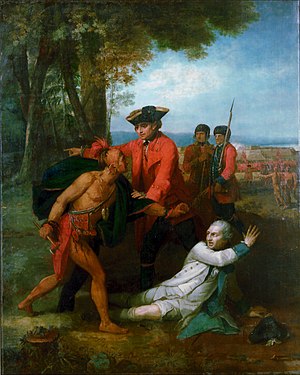Battle of Lake George
| Battle of Lake George | |||||||
|---|---|---|---|---|---|---|---|
| Part of the French and Indian War | |||||||
 Benjamin West's depiction of William Johnson sparing Baron Dieskau's life after the battle |
|||||||
|
|||||||
| Belligerents | |||||||
|
Province of New York Some Mohawk Warriors |
|
||||||
| Commanders and leaders | |||||||
|
William Johnson William Eyre Hendrick Theyanoguin † Ephraim Williams † Phineas Lyman |
Jean Erdman, Baron Dieskau (POW) Jacques Legardeur de Saint-Pierre † |
||||||
| Strength | |||||||
| 1,500 British colonial militia 200 Mohawk Warriors |
1,500 regulars, militia, and natives |
||||||
| Casualties and losses | |||||||
| 331 total ? Disputed (see 'Losses') | 339 total ? Disputed (see 'Losses') | ||||||
The Battle of Lake George was fought on 8 September 1755, in the north of the Province of New York. The battle was part of a campaign by the British to expel the French from North America in the French and Indian War.
On one side were 1,500 French, Canadien, and Indian troops under the command of the Baron de Dieskau and on the other side 1,500 colonial troops under William Johnson and 200 Mohawks led by a noted war chief, Hendrick Theyanoguin.
William Johnson, who had recently been named the British agent to the Iroquois, arrived at the southern end of Lac Saint Sacrement on 28 August 1755 and renamed it Lake George in honor of his sovereign, George II. His intention was to advance via Lakes George and Champlain to attack French-held Fort St. Frédéric at Crown Point, which was a keystone in the defense of Canada.
With a view to stopping Johnson's advance, Dieskau had already left Crown Point for an encampment situated between the two lakes (later to be built into Fort Carillon, the precursor of Fort Ticonderoga.) On 4 September Dieskau decided to launch a raid on Johnson's base, the recently constructed Fort Edward (at the time called Fort Lyman) on the Hudson River. His aim was to destroy the boats, supplies and artillery that Johnson needed for his campaign. Leaving half his force at Carillon, Dieskau led the rest on an alternate route to the Hudson by landing his men at South Bay and then marching them east of Lake George along Wood Creek. Dieskau arrived near Fort Edward on the evening of 7 September 1755 with 222 French regular grenadiers from the Régiment de la Reine and the Régiment de Languedoc, 600 Canadian militia and 700 Abenaki and Caughnawaga Mohawk allies.
...
Wikipedia
